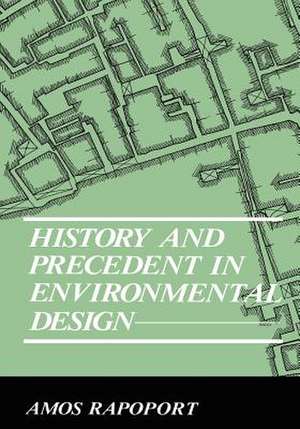History and Precedent in Environmental Design
Autor Anatol Rapoporten Limba Engleză Paperback – 30 iul 1990
Preț: 798.18 lei
Preț vechi: 973.39 lei
-18% Nou
Puncte Express: 1197
Preț estimativ în valută:
152.75€ • 158.89$ • 126.10£
152.75€ • 158.89$ • 126.10£
Carte tipărită la comandă
Livrare economică 14-28 aprilie
Preluare comenzi: 021 569.72.76
Specificații
ISBN-13: 9780306434457
ISBN-10: 0306434458
Pagini: 540
Ilustrații: 540 p.
Dimensiuni: 178 x 254 x 27 mm
Greutate: 0.91 kg
Ediția:Softcover reprint of the original 1st ed. 1990
Editura: Springer Us
Colecția Springer
Locul publicării:New York, NY, United States
ISBN-10: 0306434458
Pagini: 540
Ilustrații: 540 p.
Dimensiuni: 178 x 254 x 27 mm
Greutate: 0.91 kg
Ediția:Softcover reprint of the original 1st ed. 1990
Editura: Springer Us
Colecția Springer
Locul publicării:New York, NY, United States
Public țintă
ResearchDescriere
This book is about a new and different way of approaching and studying the history of the built environment and the use of historical precedents in design. However, although what I am proposing is new for what is currently called architectural history, both my approach and even my conclusions are not that new in other fields, as I discovered when I attempted to find supporting evidence. * In fact, of all the disciplines dealing with various aspects of the study of the past, architectural history seems to have changed least in the ways I am advocating. There is currently a revival of interest in the history of architecture and urban form; a similar interest applies to theory, vernacular design, and culture-environment relations. After years of neglect, the study of history and the use of historical precedent are again becoming important. However, that interest has not led to new approaches to the subject, nor have its bases been examined. This I try to do. In so doing, I discuss a more rigorous and, I would argue, a more valid way of looking at historical data and hence of using such data in a theory of the built environment and as precedent in environmental design. Underlying this is my view of Environment-Behavior Studies CEBS) as an emerging theory rather than as data to help design based on current "theory. " Although this will be the subject of another book, a summary statement of this position may be useful.
Cuprins
I The Argument.- 1 • History of What?.- The Subject Matter of Environmental History.- Subdividing the Domain.- Methodological Implications.- 2 • History for What?.- Approaches to History.- Some Examples.- Implications for Theory.- 3 • What History?.- Being “Scientific”.- Broad Outline of the Approach.- Art History and Architectural History.- Changes in the Study of Art: The Case of Rock Art.- From the Study of Art to the Study of the Built Environment.- The Relation between Past and Present.- Inference.- Inference in Science and History.- Uniformitarian Assumptions.- Conclusion.- II The Supporting Arguments.- 4 • Supporting Argument 1.- The Supporting Argument from the Social Sciences.- The Supporting Argument from History.- Some Specific, Implicit Supporting Arguments.- Explicit Supporting Arguments.- The Supporting Argument from the “Historical” Sciences.- Science in General.- Cosmology.- Life on Earth—The Biological and Evolutionary Sciences.- Paleontology.- Human Evolution.- 5 • Supporting Argument 2: Archaeology/Prehistory.- A Conscious and Explicit Concern with Epistemological Issues.- Redefining the Domain.- Posing Clear and Explicit Questions.- Explicitness, Rigor, Logic, Clarity, and Precision.- Objectivity.- Rigorous Mutual Criticism.- Self-Correction, Cumulativeness, and Rapid Progress.- Need for an Empirical Base.- The Handling of Data.- Methodological Sophistication, Multiple Methods, and Taxonomy.- Interdisciplinary and Multidisciplinary Approaches.- Search for Pattern.- Generalization, Explanation, and Theory.- Controlled Use of Analogies.- Prediction.- The Development of Theory.- Models and Model Testing.- Inference.- Some Examples.- III Case Study: Pedestrian Streets.- 6 • Pedestrians and Settings.- Environment-Behavior Studies.- Pedestrian Behavior.- Walking and Settings.- Literature Review.- 7 • The Perceptual Characteristics of Pedestrian Streets: The General and Specific Hypotheses.- Complexity.- Noticeable Differences.- Effects of Speed of Movement.- The General Hypothesis.- The Specific Hypotheses.- 8 • The Evidence: The Sample and the Method.- The Evidence.- The Sample.- The Method.- The Data.- Conclusion.- Implications of the Case Study.- What Do the Data Show?.- What Do the Data Mean?.- What Are the Implications of the Case Study?.- Implications of the Book as a Whole.- References.

















